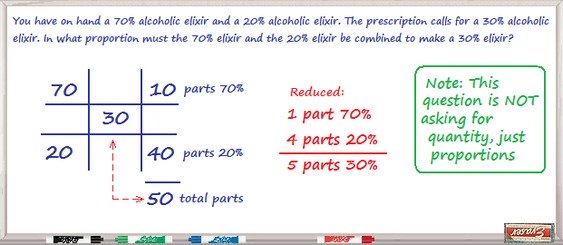Pharmacy Tech Math - Alligation tutorial II
By Ron Aylor, CPhT
Why Alligation?
It's typically more practical to dilute an existing known strength preparation than to compound a new preparation which may involve weighing, heating, and extensive mixing of all the ingredients to achieve the finished product.
When can it be used?
1) When you want to calculate the amount of diluent to be added to an already prepared higher strength preparation to form a lower strength.
2) For mixing two products of different strengths to form a product having a desired intermediate strength.
How to do it
Draw a problem matrix (tic-tac-toe). Insert quantities as shown and subtract along the diagonals. Read along the horizontals to obtain the number of parts for both the higher and lower strength.
|
Alligation Example #1 |
You have on hand a 70% alcoholic elixir and a 20% alcoholic elixir. The prescription calls for a 30% alcoholic elixir. In what proportion must the 70% elixir and the 20% elixir be combined to make a 30% elixir? A. 2 parts 70% / 1 part 20% |
After drawing the problem matrix, inserting the
quantities, and subtracting along the diagonals, we get 10 parts of the
70% elixir and 40 parts of the 20% elixir. (And, since both numbers have a common denominator, reduce them)
This means that if one part of 70% elixir is mixed with four parts of 20% elixir, it will yield five parts of 30% elixir. The dotted arrows in the matrix above are a reminder that the total number of parts always represents the desired strength.
Go to the next page - Alligation example #2
Where would you like to go now?

